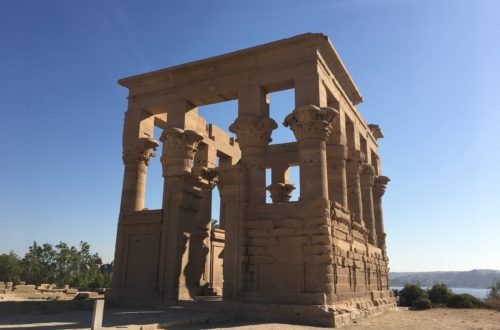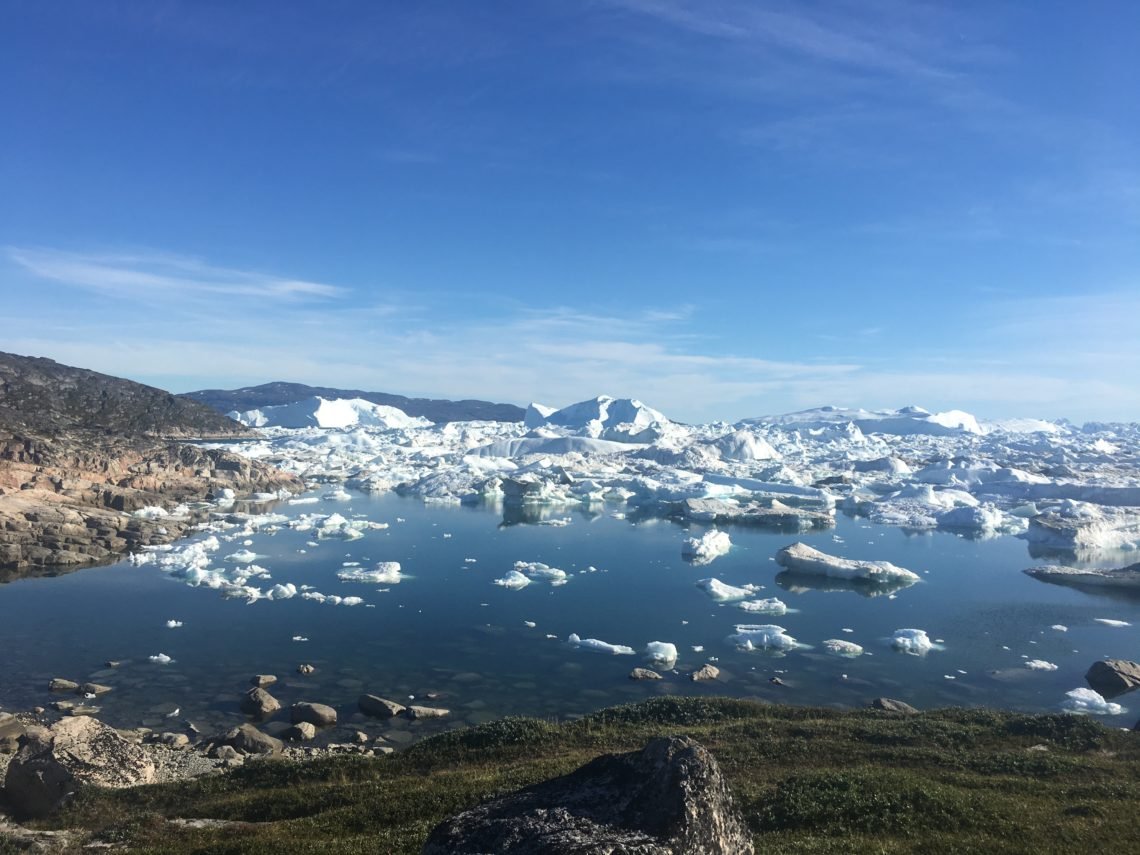
Summertime in the Iceberg City of Greenland – Ilulissat
Greenland is often seen as a far away northern territory, entirely white, kingdom of the Inuit wearing fur clothes and of the endangered yet majestic polar bear. While there is some truth in this statement, it does however give a very narrow and incomplete vision of the ground reality.
/ Flying over the Greenlandic icecap
/ The iceberg city: a smart blend of historical and modern
/ An ancient world of ice… yet full of life
/ The fastest glacier in the world
/ Once upon a time in far far away Oqaatsut
/ Related: Greenland, Ilulissat, Disko Bay, Rodebay, Oqaatsut, Semmermiut, iceberg, ice fjord, glacier, icecap, UNESCO World Heritage Site
/ Inspiration: Paul-Emile Victor – J’ai toujours vécu demain (by Daphné Victor & Stéphane Dugast)
I spent one week in Ilulissat in late July, just when the midnight sun was officially ending. My personal experience proved to be quite different: colourful, diverse, not a single polar bear at the horizon but equally fascinating whales spotted in the Disko Bay. With just about five thousands inhabitants, excluding sled-dogs (!), it is the third city in the country. In Greenlandic, Ilulissat translates into “iceberg”. A well deserved name since the area is surrounded by the drifting icebergs from the nearby ice fjord (a UNESCO World Heritage Site since 2004).
Flying over the Greenlandic icecap
One hour after take off from Iceland’s capital Reykjavik, white spots sprinkle the dark blue sea beneath our Air Greenland aircraft: icebergs! Their concentration increase until the waters turn milky to the eye. Suddenly, dramatic rocky shores emerge on the horizon. We are reaching Eastern Greenland’s coast.
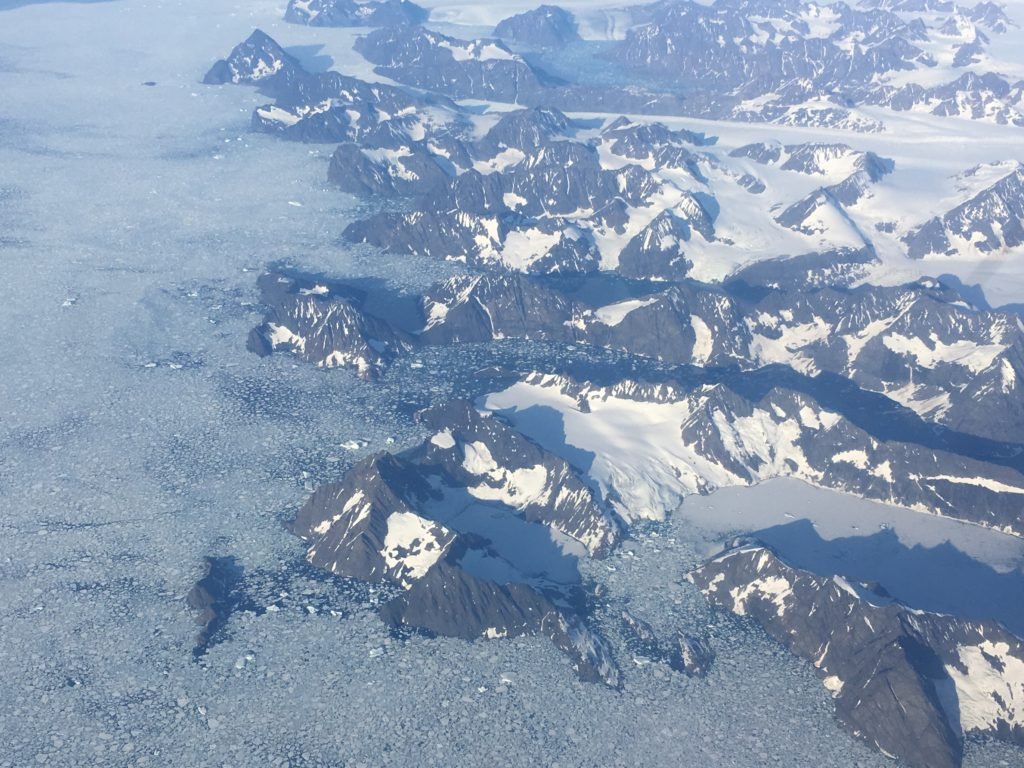
As we progress further above mainland the 1.000m to 2.000m high peaks slowly disappear under the icecap. Then, nothing, a uniform white blanket stretches to infinity. I loose the sense of distance. The clouds and fog envelop the atmosphere around us, the horizon line fades. I reflect that I am actually having a live visual of true nothingness, a strange sensation if truth be told.
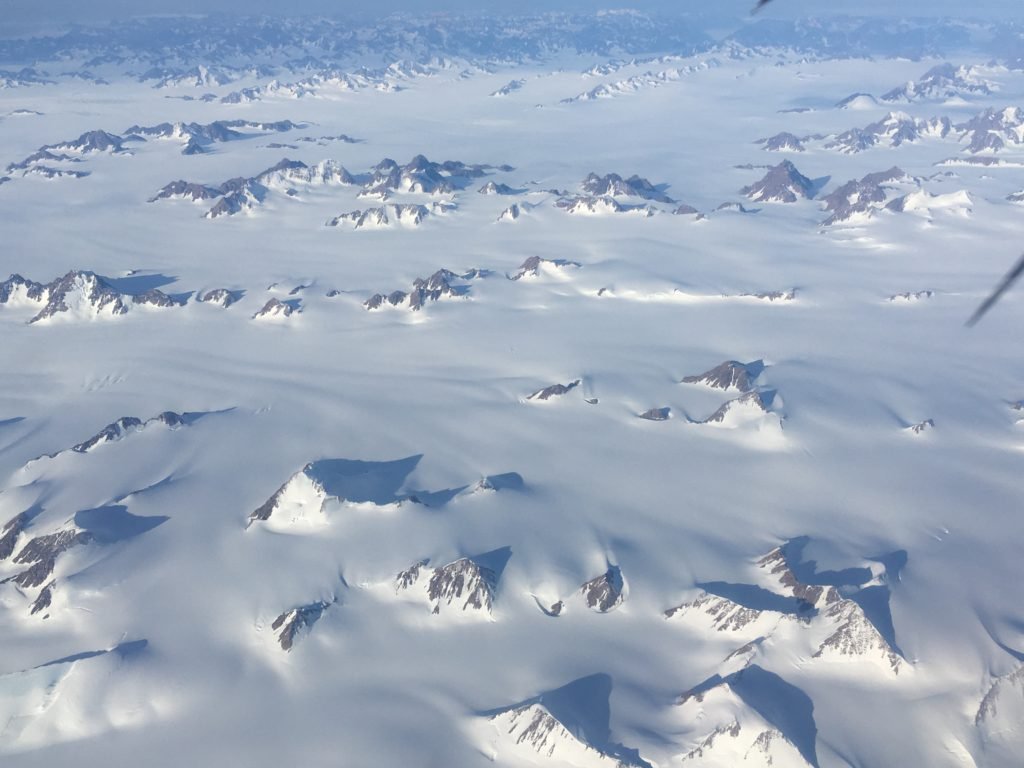
Later on, as a mirror to the prior vision, blue spots appear on the white coat. Variation of stunning turquoise to dark blue look almost supernatural. Their shape evoke dozens of wide open eyes staring at the sky, guardians of some deep secret. The Western coast is now close and the aircraft prepares for landing on Ilulissat’s tiny runway along Disko Bay.

The iceberg city: a smart blend of historical and modern
The longest road segment in Ilulissat which connects the city centre to the airport is less than 6 kilometers long! To get outside the town, three options: by foot, by sea or by air. In winter time, dog sledding would be a fourth option. I don’t know it yet, but I will soon find myself on a 42 kilometers trek and flying a few meters above the ice fjord and glacier.
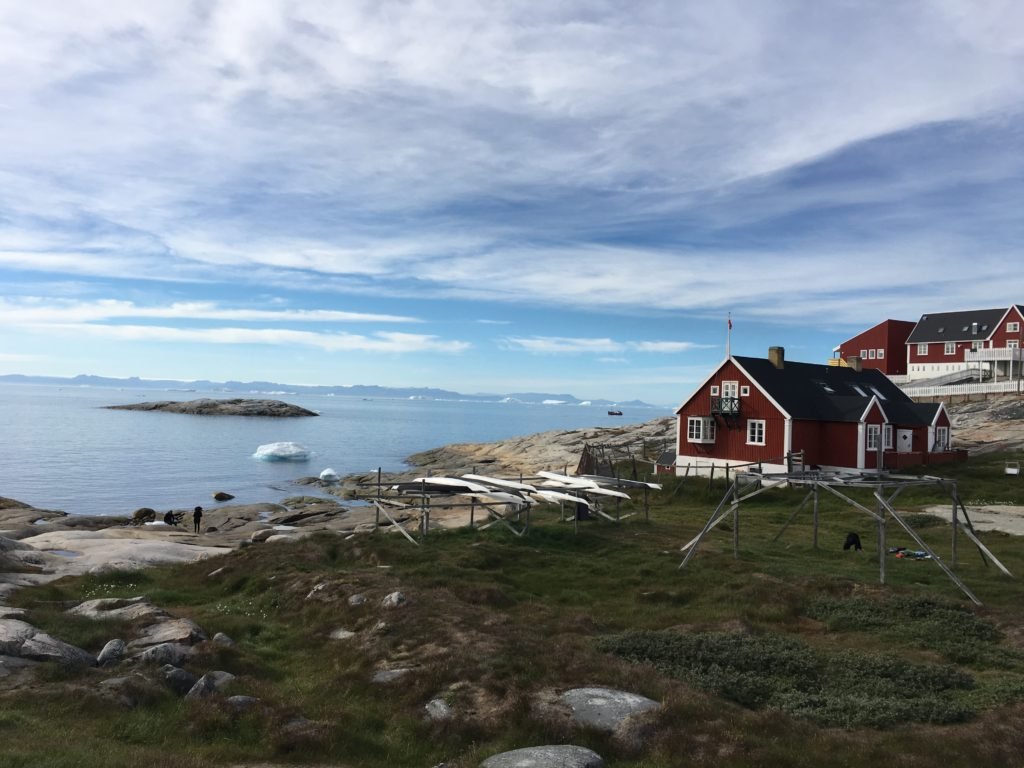
Historically, houses were painted according to their function: hospital, school, church and so on. The purpose in the early days of the settlement was to help the natives and visitors recognize the buildings easily. Nowadays, everyone can paint their house the colour they like. The majority will stick to the traditional red, blue, yellow and green. But some originality pops up here and there with exotic turquoise and purple. The result is a colourful patchwork on the gentle hills facing the icebergs.
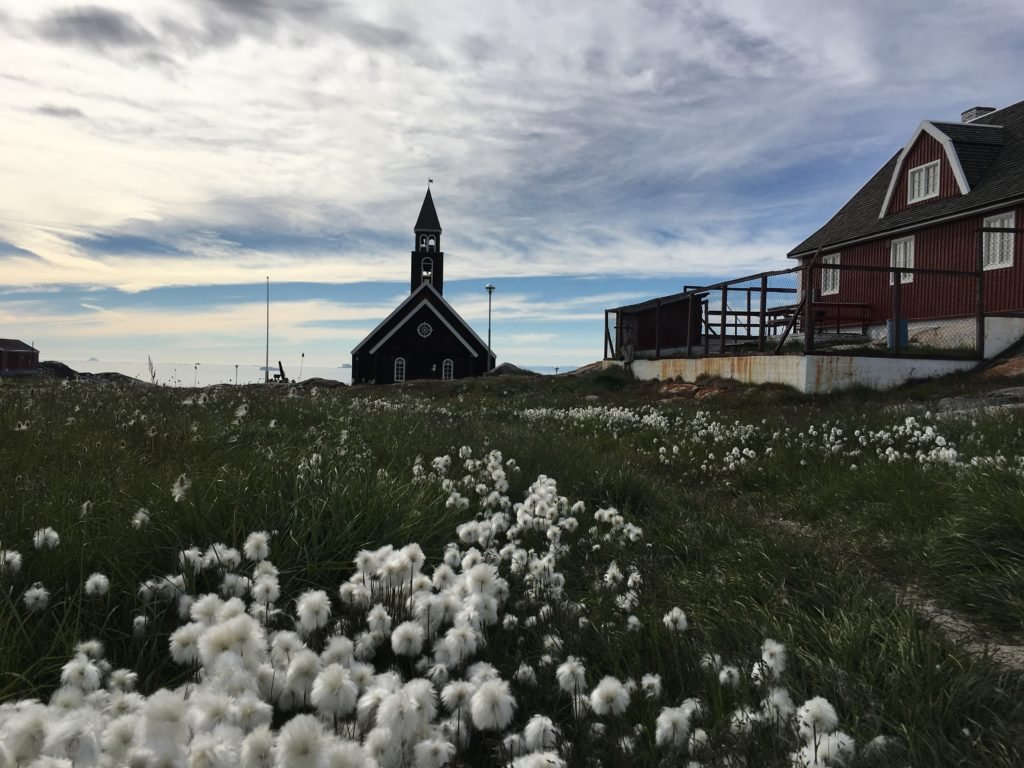
Near the shore lay the red hospital, the “kayak house” and polar explorer Knud Rasmussen’s birthplace house (turned into a museum in 1995). Like a sentinel, the black wooden Zion church was actually displaced a few meters up to its current location in 1929. The formation of icebergs can sometimes create tsunamis, some of which are deadly. Hence, the constructions usually observe a minimum safety distance to the shore.
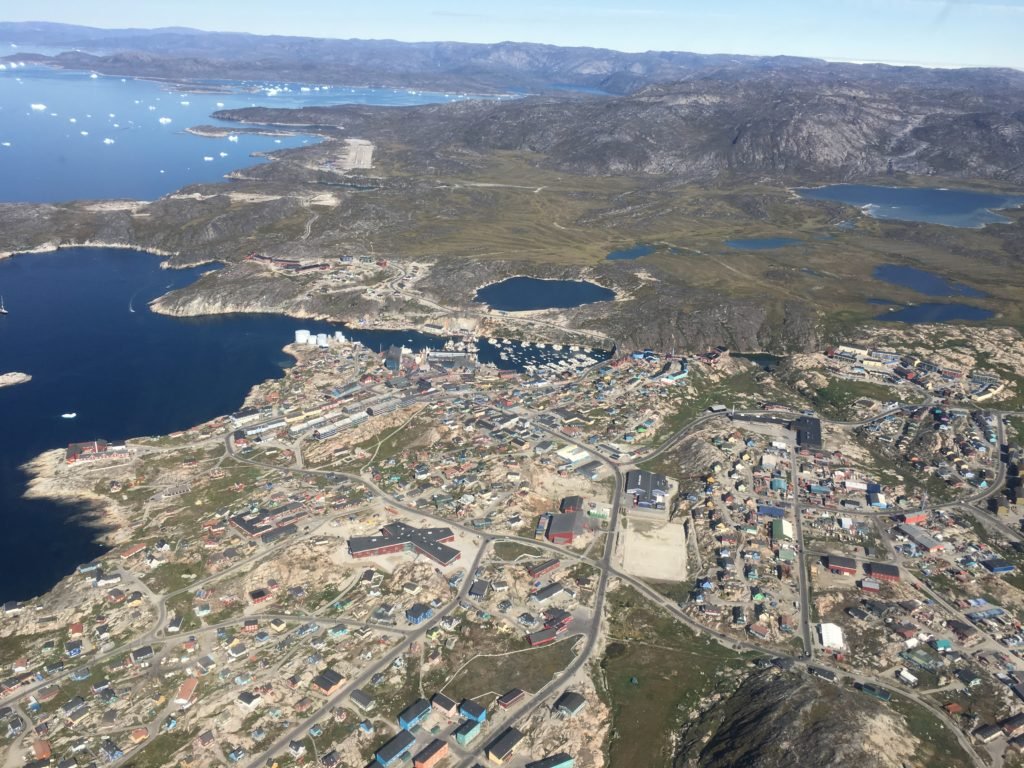
Climbing on the upper part of the town, I stop at the tiny Kangia Café which will actually become my friendly daily routine. Both locals and visitors frequent this place. It is a great way to meet people and learn about the area. The hot chocolate is very nice, the food is generous and tasty. And they offer internet rates! The bank, post office, supermarket and travel agencies are all available in an area covering less than a square kilometre. Back in 1741, it was a newly established colony called Jakobshavn. Today, Ilulissat mainly relies on fishing and tourism and it is the growth centre of North Greenland.
An ancient world of ice… yet full of life
The major part of the year, the ground is covered by ice and snow. But in summer, the low vegetation flourishes. Not a tree to be seen at the horizon. Instead, a multitude of mosses, lichens, bushes and flowers catch the eye unexpectedly. The contrast with the pinky grey rocks and the white bluish icebergs is breathtaking. The fauna is not left behind either. Sparrows near the ground, crows in the falling rocks formations and birds of prey in the sky glide in a restless ballet. They each have their distinctive songs that resonate in the clear air. From time to time, the characteristic thunder turmoil of breaking ice reaches the ear. A new iceberg has just been born.

I follow carefully the trail marked by coloured piles of stones. The air smells of ice, mineral and dry bushes. Down the hills, the water is crystal clear and the 1.8 billion year old rocks have a soft shape. Everything is brighter, clearer and purer in this part of the world, truly. In this ever changing environment, there is an overwhelming peaceful atmosphere.
Less poetic are the flies and mosquitoes that welcome you happily in some areas. Fortunately they are not such a nuisance if you apply repellent and keep walking steadily. Following the course of the icebergs, I reach the very end of the ice fjord’s mouth, where it joins the waters of Disko bay. It is only 6 o’clock but the light is changing and it is a complete new landscape I discover at the 4.000 year old Semmermiut settlement. The surface of the water is a mirror, everything is still for a moment, time is suspended.
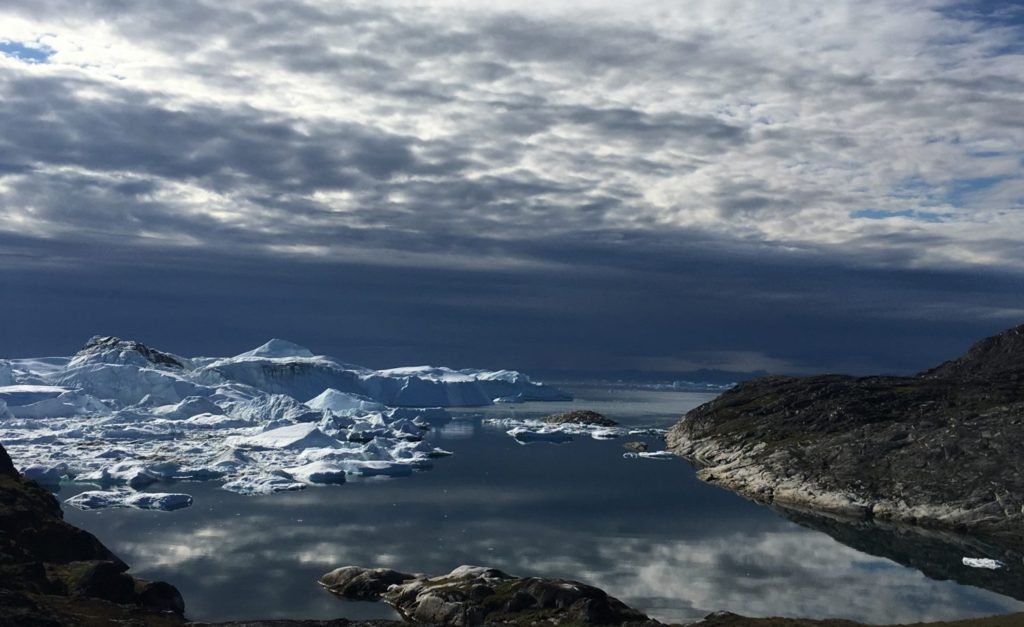
The bay has yet another surprise in store for me. The weather turns cloudy and the bay is now displaying wonderful shades of blue, grey and white on its surface. A deep sound resonates on the rocks. At first I thought it was another distance iceberg breaking free. Soon enough it becomes clear that the sound is different and occurring with a well defined tempo. I look down at the bay, and there it is, a dark whale breaks into the surface with a deep breath. The show continues during several minutes until the whale finally dives back into the quiet waters.
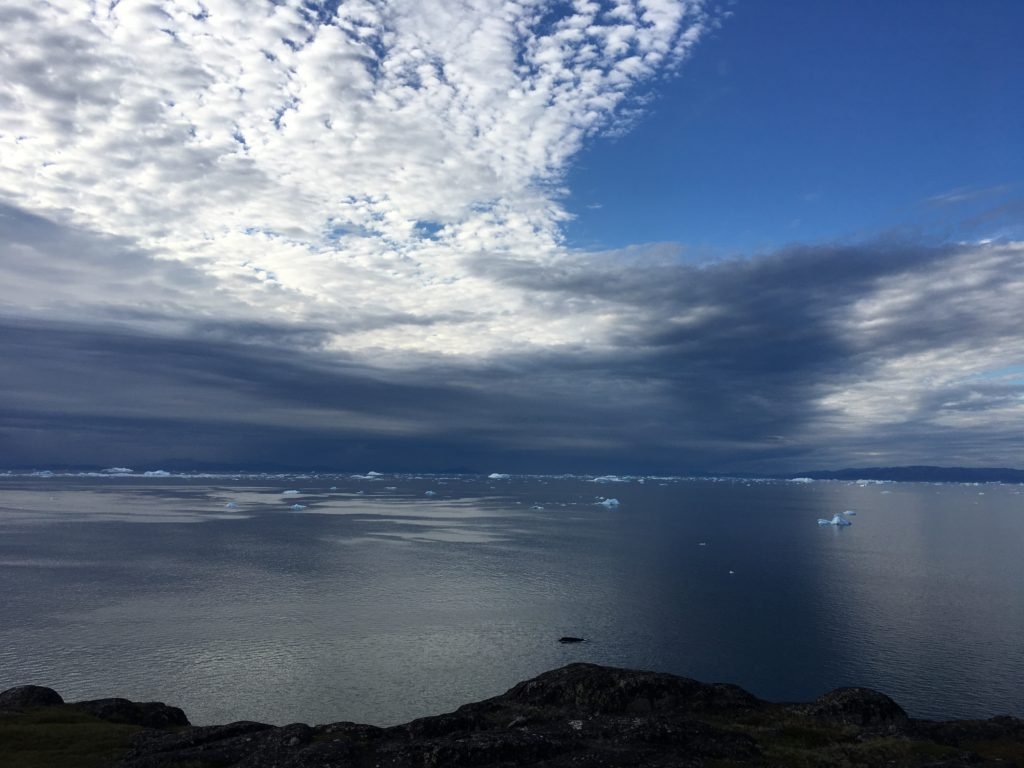
The day is almost over and the sun is finishing its daily course. The sky turns yellow, orange and red, the icebergs in the bay are pink and purple. It is passed midnight, the sun is surfing endlessly on the wave of horizon and finally sinks into the water. It will not get dark though, the sun will reappear on the horizon in one hour or so. And a new day will start.
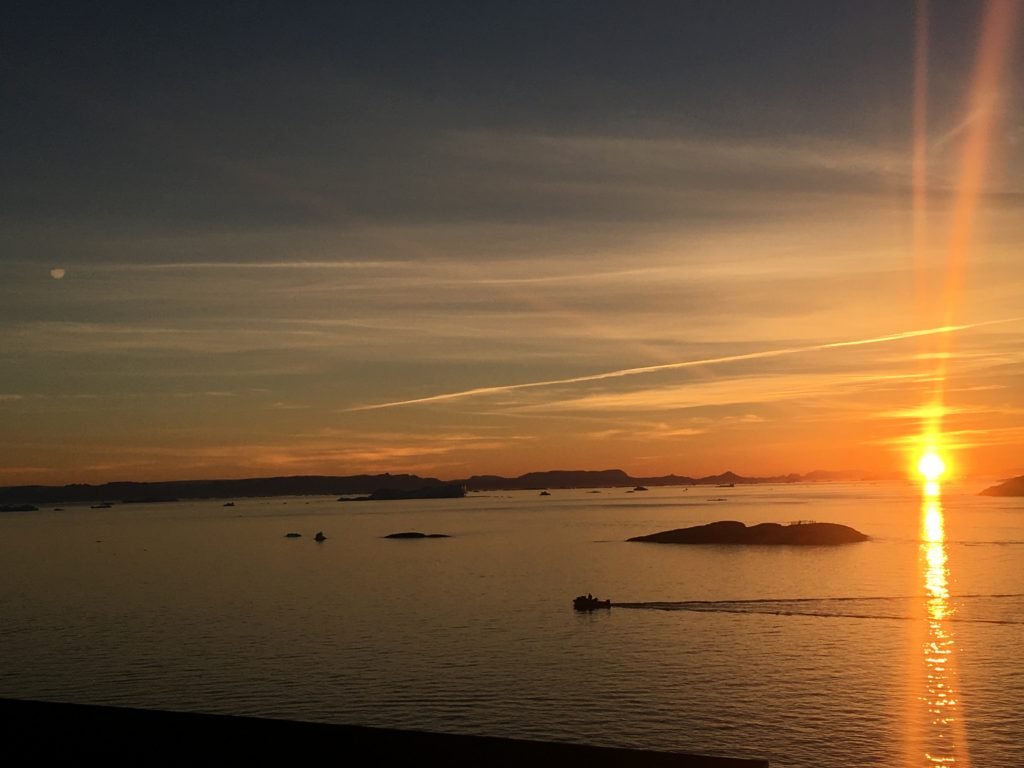
The fastest glacier in the world
Sermeq Kujalleq moves at an astonishing pace of 40 meters a day. It calves about 46 km3 of ice every year, which represents 10% of all Greenland ice calf’s production. Yet this fast moving ice giant is shrinking dramatically.
I booked a helicopter tour through World of Greenland agency. Helicopter is actually the only way to get to the heart of the UNESCO World Heritage Site and to land at the foot of the glacier. I join 10 other passengers from all nationalities. During 25 minutes, we fly over the ice fjord, white spotted blue tongue caught between rocky hills. The horizon gets ice blue as we approach the glacier’s front line.
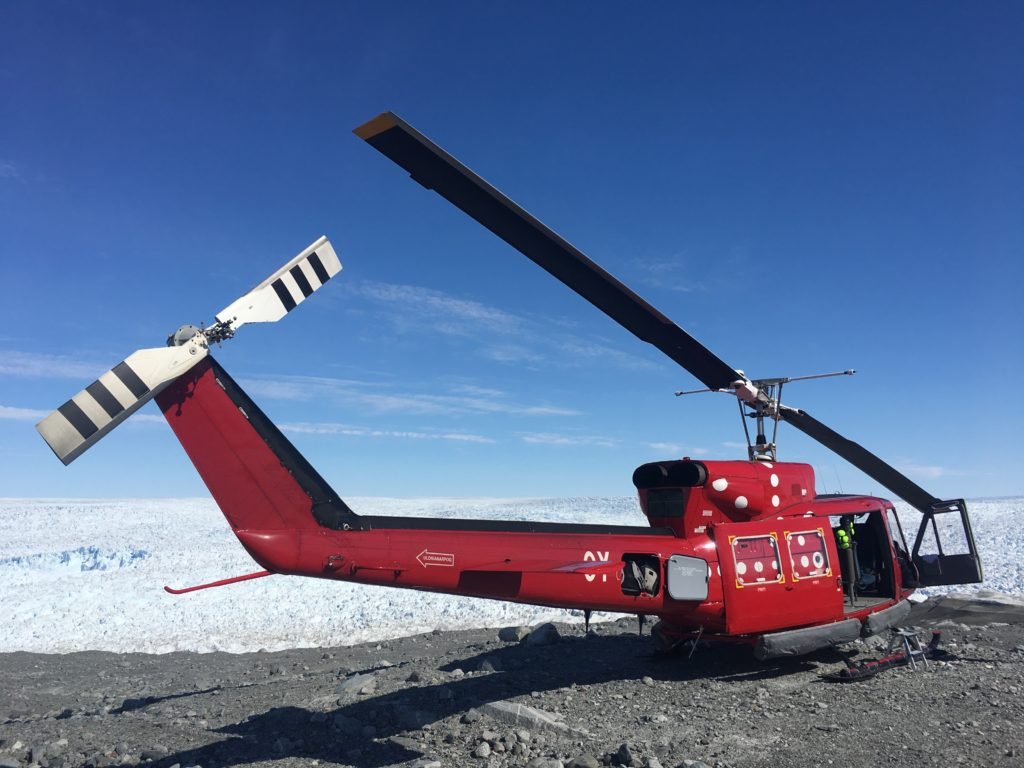
The pilot lands smoothly on the moraine deposit, we are now allowed half an hour freedom to explore the area on foot. I exit the aircraft and walk down the stony hill towards the glacier. Ten minutes later I understand I will not make it to the ice, it is too far away and I have to be back in time to the helicopter for the return flight.
The landscape is lunar. I feel like we landed on some far away planet. My brain struggles to admit I am actually on Earth, 250km north of the Arctic Circle. What surprised me most during these precious minutes spent there? The overwhelming silence and the surprising colour variety of the stones beneath my feet. From the sky it looked all grey and dusty. In reality, gneiss and granites display wonderful variations of pink, yellow, black, green and white.

Our pilot later told me that the area we landed in became accessible only 5 to 6 years ago. For thousands of years, the ground had been covered with tons of ice and it lays today completely naked. I was shocked. 5 to 6 years is a blink in geological terms. Suddenly, all the abstract global warming and icecap melting warnings are just real, happening right in front of me. The ice that once stood where I am now standing is simply gone!
Before heading back to Ilulissat, we fly low over the edge of the 7 kilometers wide glacier. Thousands of deep crevasses look at us a we circle in the sky. For those who follow the Game of Thrones series or read A Song of Ice and Fire novels, no doubt the glacier echoes the Wall. Just to put things into perspective, the Wall by G.R.R. Martin is over 700 feet tall (approx. 213 meters) whereas the Sermeq Kujalleq glacier’s front is “only” 40 to 90 meters high. Still, very impressive!
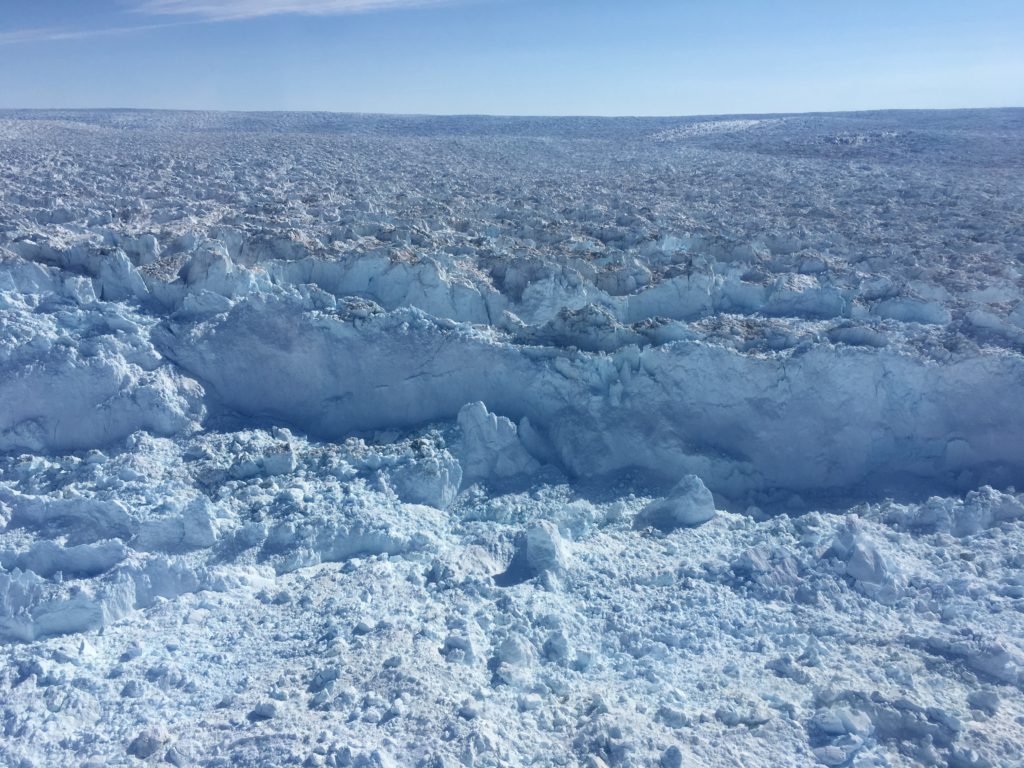
Once upon a time in far far away Oqaatsut
Someone in town told me about the Oqaatsut settlement on Rodebay, north of Ilulissat. It was not clear at the time what the exact distance was. Somewhere between 15 and 18 kilometers one way. As a matter of fact, it happens it was closer to 21km! Usually it is a two day trip with overnight in the settlement. The last time I did a day trek was half a year ago, in New Zealand, and it was “just” 20km long. Believe it or not, I was confident enough I could manage it on a day trip. The following day, I packed food, water, sun cream and a small emergency kit and left Ilulissat around 7.30AM.
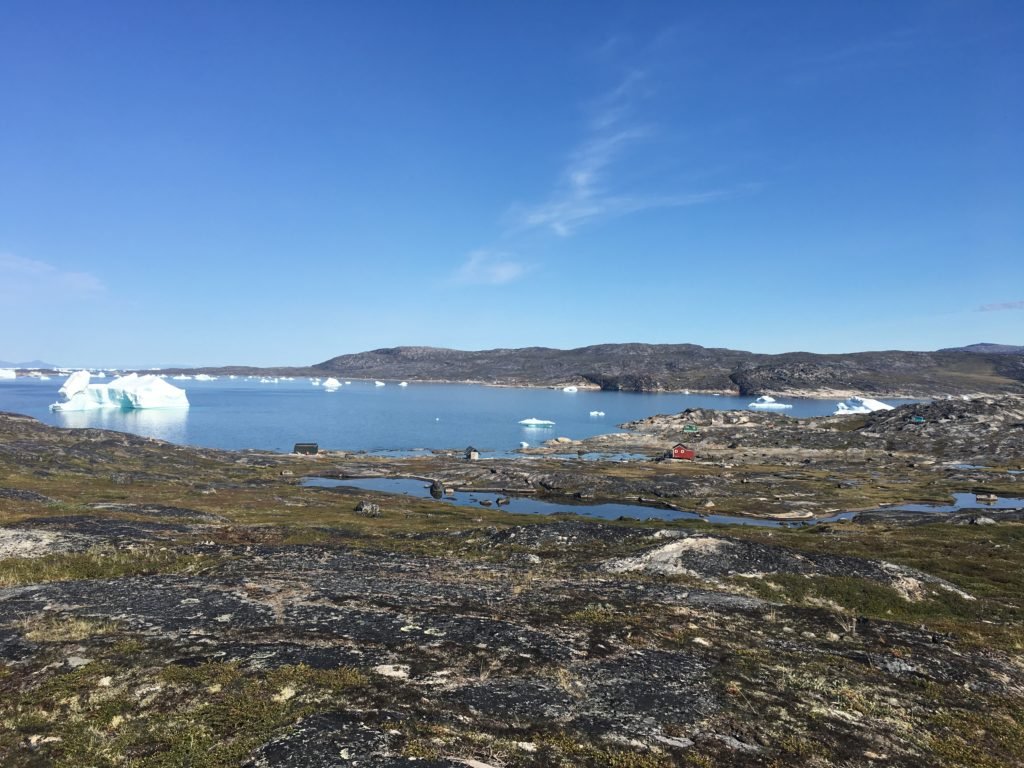
The good thing about this trip is that the trail is reasonably well marked with orange painted stone mounds. It is also midnight sun season, so no risk of getting caught by the dark. And there are no polar bears in the region, at least not at the moment. Or so the locals told me.
Passing on the bridge, I look down at the harbour with its fleet of hundreds of ships. It is quiet and a lovely sunny day. One hour later I leave behind me the airport and continue my route North into the arctic wilderness. Drifting icebergs of all shapes accompany my journey. The water is crystal clear, you can actually see through it. Here and there, a few isolated summer houses stand near the shore.
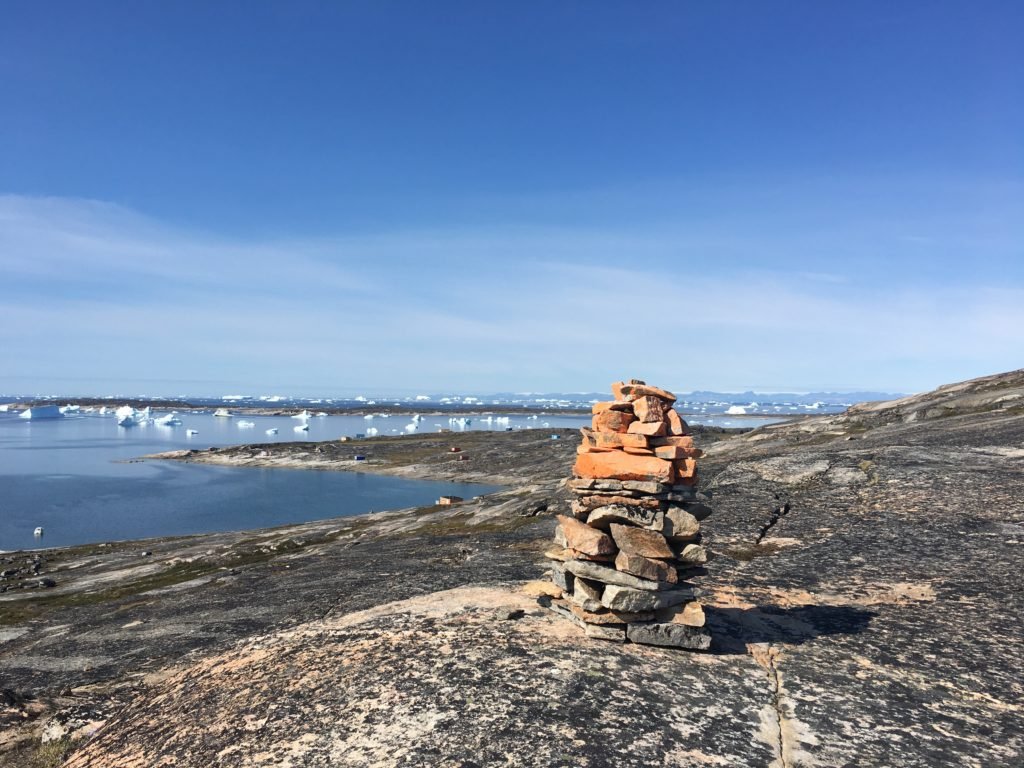
The ground is uneven and the landscape completely changes as the hours pass by. Muddy wet lands alternate with rocky formations, trapped lakes, steep hills and wild streams. I met less people on the road that day than there are fingers on my hand! Finally I reach the Oqaatsut settlement. This is a complete different world.
Oqaatsut is home to 42 residents and one of the smallest villages in Greenland. No roads here, the houses are standing directly on the rocks, facing the bay. A few sled-dogs, five or six people outside, a couple of children playing and the fishermen busy on their boats. Summer repair work is ongoing. One restaurant: H-8, inside a red renovated colonial building. In this remote area, life goes on, thousands of miles away from traffic, subways, skyscrapers and forests. It is already time for me to head back to Ilulissat and the ice fjord. I will not deny that the last hour has been challenging but I proudly completed the 42km trek in just over 10 hours. This journey changed me, made me look at things from a different perspective.
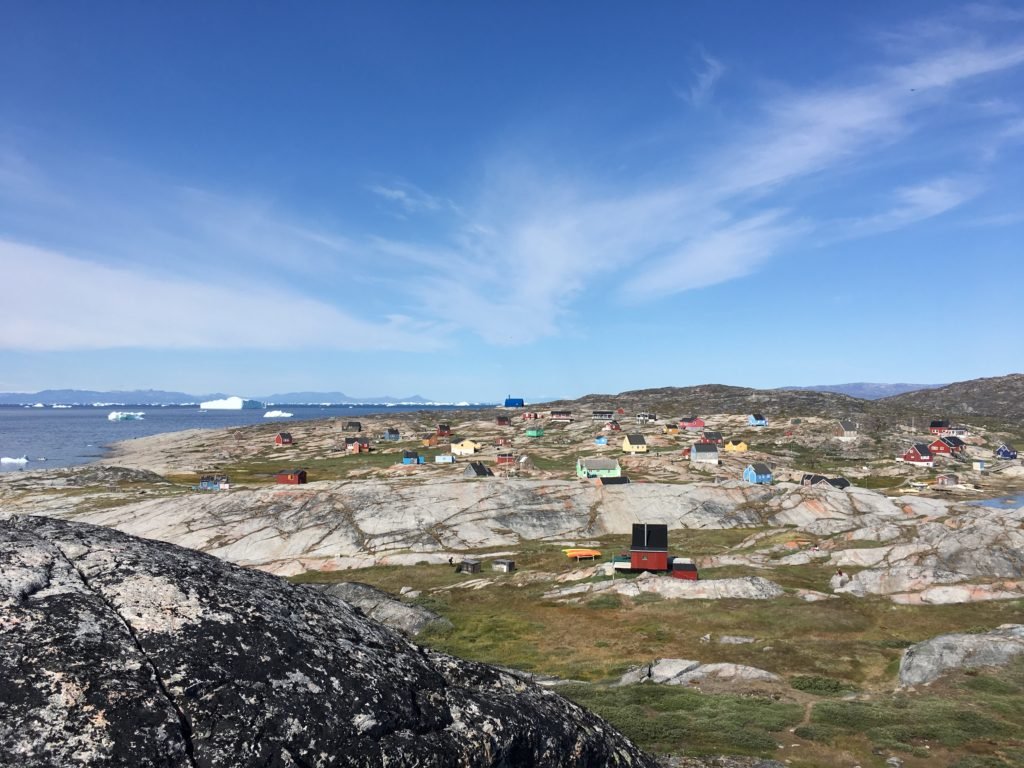
Greenland is a preserved territory of superlatives. It is the largest island in the world (over 2 million square kilometers). With a population of 56.000, it also has the lowest population density (0.03 pop/km2). It hosts the most active and fastest moving glacier in the world (Sermeq Kujalleq). Greenland’s inland ice is the largest icecap in the world after the Antarctic. Testimony of the power of Nature is everywhere, yet it is a fragile environment, a beautiful and peaceful place like no other.
Want to learn more about Greenland and Ilulissat? Here are a few links:
http://www.geus.dk/viden_om/voii/ilulissat-uk/voii02-uk.html
http://www.kangia.gl/Fakta%20om%20isfjorden/Geologi?sc_lang=en
http://whc.unesco.org/en/list/1149/
https://visitgreenland.com/about-greenland/flora-greenland/
http://qaasuitsup-kp.cowi.webhouse.dk/en/plans_for_towns_and_settlements/ilulissat/
http://bank.stat.gl/pxweb/en/Greenland/?rxid=e3e9b109-8746-4ea0-b511-500e09d16d26

